2007 BMW MOTORRAD G 650 XCOUNTRY wheel
[x] Cancel search: wheelPage 4 of 126
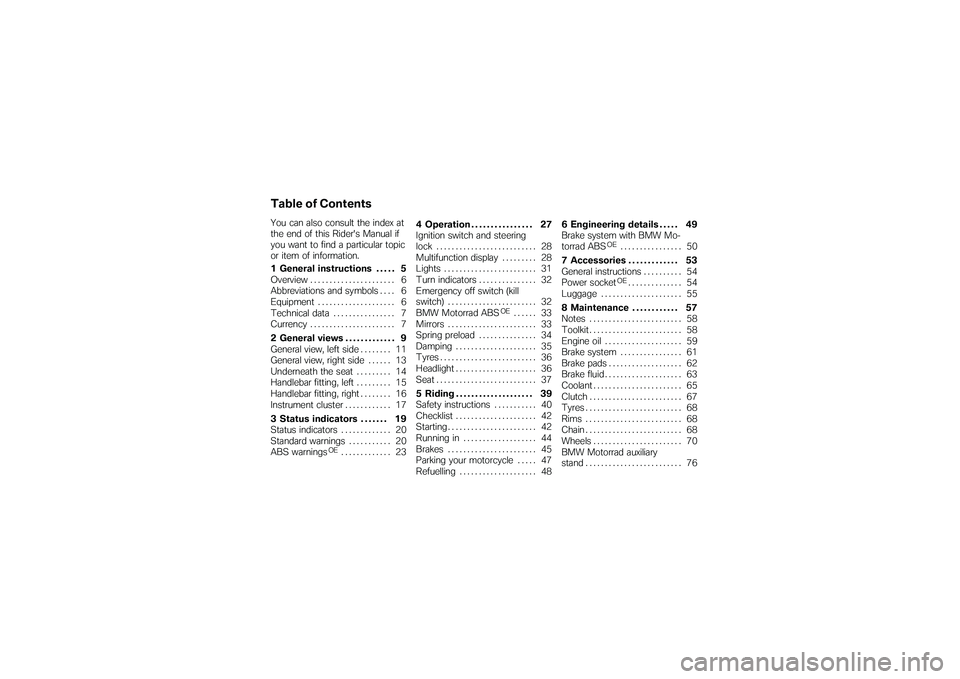
Table of ContentsYou can also consult the index at
the end of this Rider's Manual if
you want to find a particular topic
or item of information.
1 General instructions . . . . . 5
Overview ...................... 6
Abbreviations and symbols . . . . 6
Equipment . . . . . . .............. 6
Technical data . . .............. 7
Currency . ..................... 7
2 General views . . . . . . . . . . . . . 9
General view, left side . . . . . . . . 11
General view, right side . . . . . . 13
Underneath the seat ......... 14
Handlebar fitting, left ......... 15
Handlebar fitting, right . . . . . . . . 16
Instrument cluster . . . ......... 17
3 Status indicators . . . . . . . 19
Status indicators ............. 20
Standard warnings . . ......... 20
ABS warnings
OE
............. 23 4 Operation . . . . . . . . . . . . . . . . 27
Ignition switch and steering
lock . . . . . .
.................... 28
Multifunction display ......... 28
Lights . . . . .................... 31
Turn indicators . . ............. 32
Emergency off switch (kill
switch) . . . .................... 32
BMW Motorrad ABS
OE
...... 33
Mirrors . . . .................... 33
Spring preload . . ............. 34
Damping . .................... 35
Tyres . . . . . .................... 36
Headlight . .................... 36
Seat . . . . . . .................... 37
5 Riding . . . . . . . . . . . . . . . . . . . . 39
Safety instructions . . ......... 40
Checklist . .................... 42
Starting . . . .................... 42
Running in . . . . . . ............. 44
Brakes . . . .................... 45
Parking your motorcycle . . . . . 47
Refuelling .................... 48 6 Engineering details . . . . . 49
Brake system with BMW Mo-
torrad ABS
OE
................ 50
7 Accessories . . . . . . . . . . . . . 53
General instructions . ......... 54
Power socketOE.............. 54
Luggage . .................... 55
8 Maintenance . . . . . . . . . . . . 57
Notes ........................ 58
Toolkit ........................ 58
Engine oil .................... 59
Brake system . . . ............. 61
Brake pads . . . . . . ............. 62
Brake fluid .................... 63
Coolant . . . .................... 65
Clutch . . . . .................... 67
Tyres . . . . . .................... 68
Rims . ........................ 68
Chain . . . . . .................... 68
Wheels . . . .................... 70
BMW Motorrad auxiliary
stand . . . . . .................... 76
Page 5 of 126
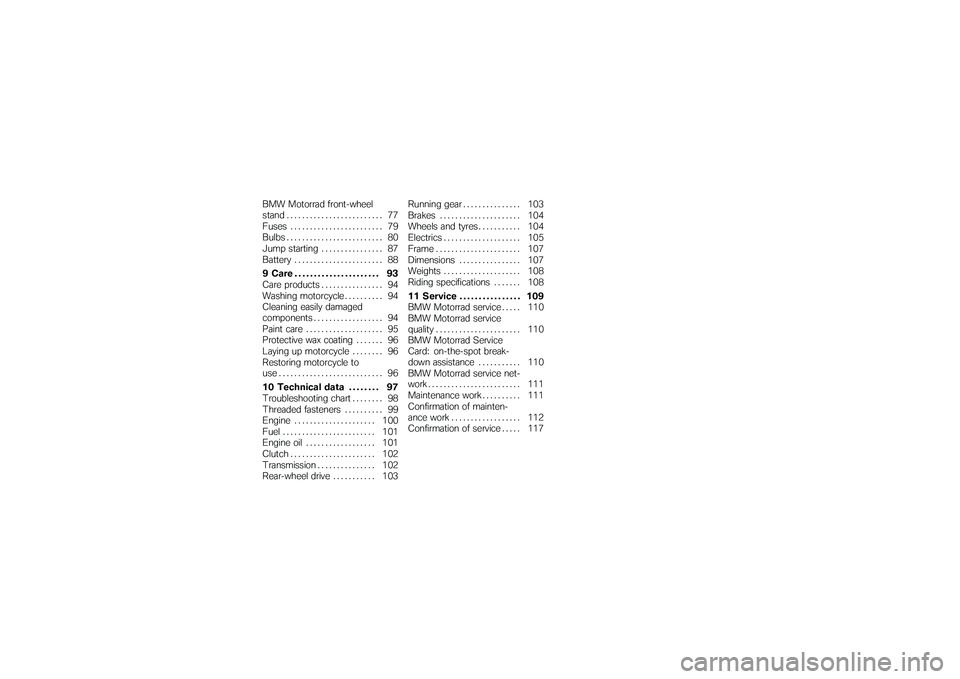
BMW Motorrad front-wheel
stand ......................... 77
Fuses ........................ 79
Bulbs . ........................ 80
Jump starting . . . ............. 87
Battery . . . . . . ................. 88
9 Care . . . . . . ................ 93
Care products . . . ............. 94
Washing motorcycle . . . . ...... 94
Cleaning easily damaged
components . ................. 94
Paint care . . . ................. 95
Protective wax coating . ...... 96
Laying up motorcycle . . ...... 96
Restoring motorcycle to
use........................... 96
10 Technical data . . . . . . . . 97
Troubleshooting chart . . ...... 98
Threaded fasteners . . . . ...... 99
Engine . . . . . . ............... 100
Fuel . . ...................... 101
Engine oil . . . ............... 101
Clutch ...................... 102
Transmission ............... 102
Rear-wheel drive ........... 103 Running gear
............... 103
Brakes . . . . . . ............... 104
Wheels and tyres ........... 104
Electrics . . . . . ............... 105
Frame ...................... 107
Dimensions . ............... 107
Weights . . . . . ............... 108
Riding specifications . . . .... 108
11 Service . . . . . . . . . . . . . . . . 109
BMW Motorrad service . .... 110
BMW Motorrad service
quality ...................... 110
BMW Motorrad Service
Card: on-the-spot break-
down assistance ........... 110
BMW Motorrad service net-
work . . ...................... 111
Maintenance work . . . . . . .... 111
Confirmation of mainten-
ance work . . . ............... 112
Confirmation of service . .... 117
Page 27 of 126
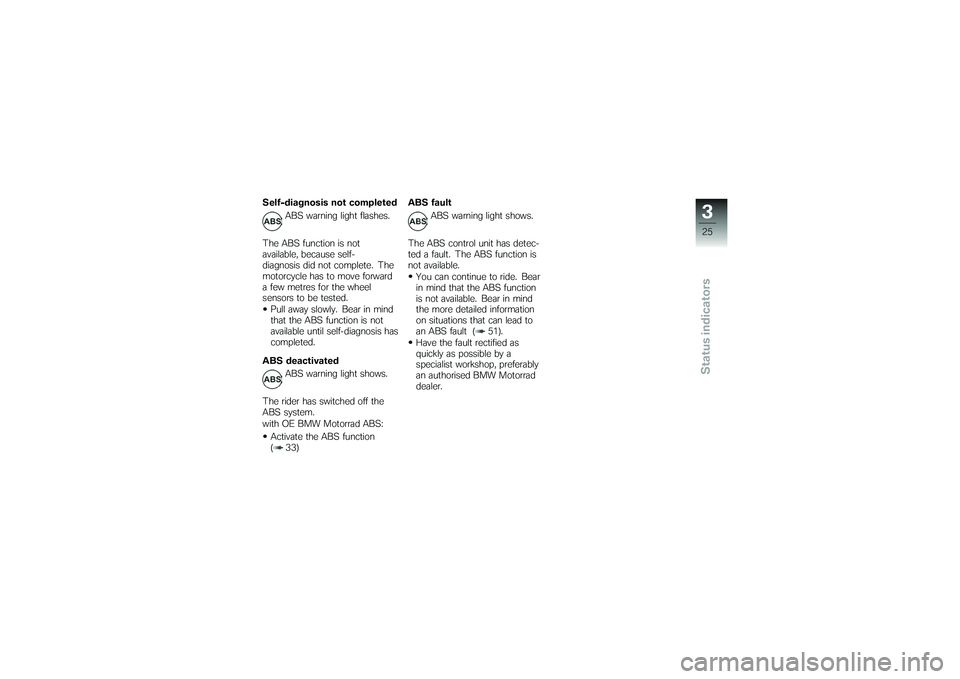
Self-diagnosis not completedABS warning light flashes.
The ABS function is not
available, because self-
diagnosis did not complete. The
motorcycle has to move forward
a few metres for the wheel
sensors to be tested. Pull away slowly. Bear in mind
that the ABS function is not
available until self-diagnosis has
completed.
ABS deactivated ABS warning light shows.
The rider has switched off the
ABS system.
with OE BMW Motorrad ABS: Activate the ABS function
( 33) ABS fault
ABS warning light shows.
The ABS control unit has detec-
ted a fault. The ABS function is
not available. You can continue to ride. Bear
in mind that the ABS function
is not available. Bear in mind
the more detailed information
on situations that can lead to
an ABS fault ( 51).
Have the fault rectified as
quickly as possible by a
specialist workshop, preferably
an authorised BMW Motorrad
dealer.
325zStatus indicators
Page 34 of 126
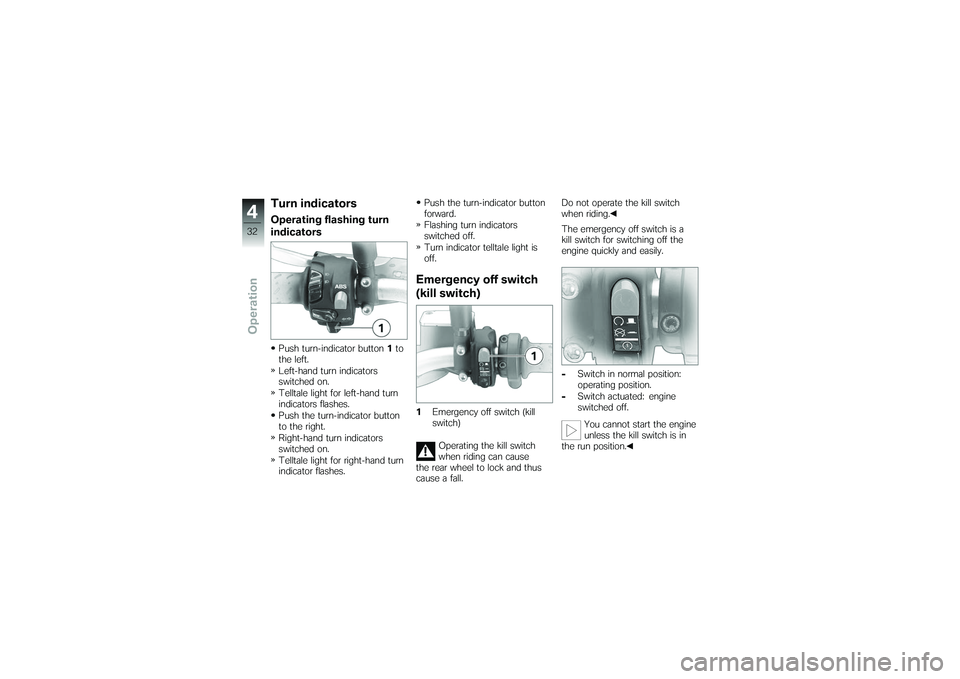
Turn indicatorsOperating flashing turn
indicatorsPush turn-indicator button1to
the left.
Left-hand turn indicators
switched on.
Telltale light for left-hand turn
indicators flashes.
Push the turn-indicator button
to the right.
Right-hand turn indicators
switched on.
Telltale light for right-hand turn
indicator flashes. Push the turn-indicator button
forward.
Flashing turn indicators
switched off.
Turn indicator telltale light is
off.
Emergency off switch
(kill switch)1
Emergency off switch (kill
switch)
Operating the kill switch
when riding can cause
the rear wheel to lock and thus
cause a fall. Do not operate the kill switch
when riding.
The emergency off switch is a
kill switch for switching off the
engine quickly and easily.
-
Switch in normal position:
operating position.
- Switch actuated: engine
switched off.
You cannot start the engine
unless the kill switch is in
the run position.
432zOperation
Page 36 of 126

Adjusting mirror armSlacken nut1.
Turn the mirror arm to the ap-
propriate position.
Tighten the nut to the spe-
cified tightening torque, while
holding the mirror arm to en-
sure that it does not move out
of position.
Union nut, mirror
20 Nm
Spring preloadAdjustment for rear
suspensionIt is essential to set spring pre-
load of the rear suspension to
suit the load carried by the mo-
torcycle. Increase spring preload
when the motorcycle is heavily
loaded and reduce spring preload
accordingly when the motorcycle
is lightly loaded.Adjusting spring preload
for rear wheelMake sure the ground is level
and firm and place the motor-
cycle on its stand. Your motorcycle's hand-
ling will suffer if you do not
match the spring-preload and
damping-characteristic settings.
Adjust the damping characteristic
to suit spring preload.
Adjusting spring preload
while the motorcycle is be-
ing ridden can lead to accidents.
Do not attempt to adjust spring
preload unless the motorcycle is
at a standstill.
Note that there is a danger
of coming into contact with
the hot exhaust silencer when
you turn the knob.
434zOperation
Page 37 of 126
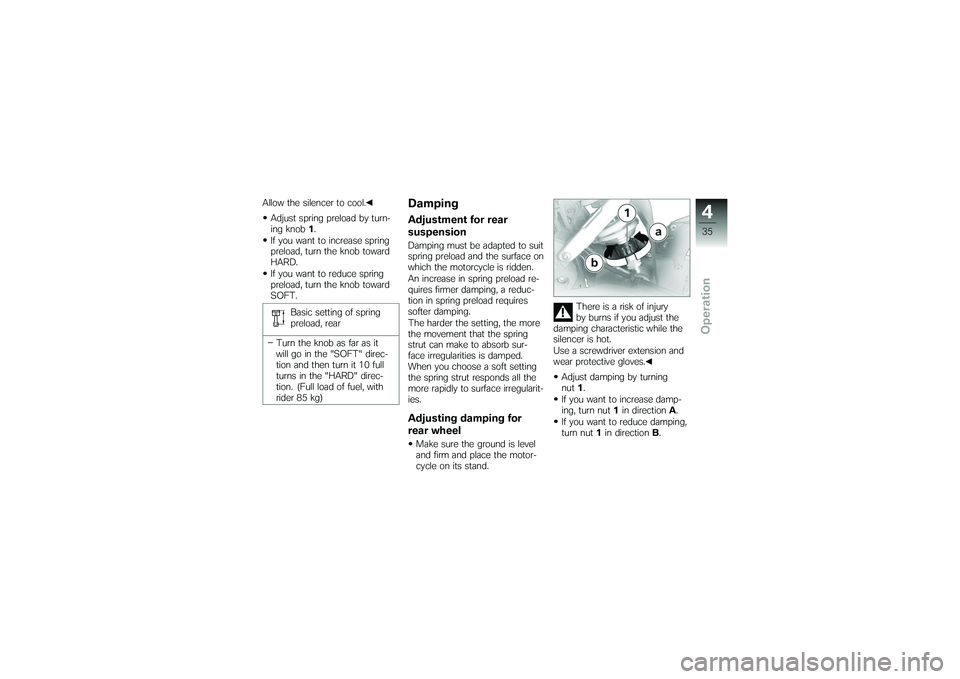
Allow the silencer to cool.Adjust spring preload by turn-
ing knob 1.
If you want to increase spring
preload, turn the knob toward
HARD.
If you want to reduce spring
preload, turn the knob toward
SOFT.
Basic setting of spring
preload, rear
Turn the knob as far as it
will go in the "SOFT" direc-
tion and then turn it 10 full
turns in the "HARD" direc-
tion. (Full load of fuel, with
rider 85 kg)
DampingAdjustment for rear
suspensionDamping must be adapted to suit
spring preload and the surface on
which the motorcycle is ridden.
An increase in spring preload re-
quires firmer damping, a reduc-
tion in spring preload requires
softer damping.
The harder the setting, the more
the movement that the spring
strut can make to absorb sur-
face irregularities is damped.
When you choose a soft setting
the spring strut responds all the
more rapidly to surface irregularit-
ies.Adjusting damping for
rear wheelMake sure the ground is level
and firm and place the motor-
cycle on its stand. There is a risk of injury
by burns if you adjust the
damping characteristic while the
silencer is hot.
Use a screwdriver extension and
wear protective gloves.
Adjust damping by turning
nut 1.
If you want to increase damp-
ing, turn nut 1in direction A.
If you want to reduce damping,
turn nut 1in direction B.
435zOperation
Page 46 of 126

If a warning light or telltale light
did not show as specified above
or if a segment or segments of
the multifunction display failed to
light up:Some malfunctions cannot
be indicated if one of the
warning lights fails to show.
Make sure that all the warning
and telltale lights come on in the
pre-ride check.
Have the fault rectified as
quickly as possible by a
specialist workshop, preferably
an authorised BMW Motorrad
dealer.ABS self-diagnosis
OE
BMW Motorrad ABS performs
self-diagnosis to ensure its op-
erability. Self-diagnosis is per-
formed automatically when you
switch on the ignition. The mo-
torcycle has to move forward a few metres for the wheel sensors
to be tested.
Phase 1
Test of the diagnosis-compat-
ible system components with
the motorcycle at a standstill. ABS warning light flashes.
Phase 2 Test of the wheel sensors as
the motorcycle pulls away from
rest. ABS warning light flashes.
ABS self-diagnosis
completed The ABS warning light goes
out.
If an indicator showing an ABS
fault appears when ABS self-dia-
gnosis completes: You can continue to ride. Bear
in mind that the ABS function
is not available.
Have the fault rectified as
quickly as possible by a
specialist workshop, preferably
an authorised BMW Motorrad
dealer.
Running inThe first 1000 kmWhile running in the motor-
cycle, vary the throttle opening
and engine-speed range fre-
quently.
Try to do most of your rid-
ing during this initial period on
twisting, fairly hilly roads, avoid-
ing high-speed main roads and
highways if possible.
Exceeding the specified en-
gine speeds while running
in will lead to increased engine
wear.
544zRiding
Page 47 of 126

Keep to the specified engine
speeds for running in.During the running-in phase,
do not exceed the speed limits
specified for the various gears.
Maximum speeds during
running-in period
max 35 km/h (1st gear)
max 55 km/h (2nd gear)
max 75 km/h (3rd gear)
max 95 km/h (4th gear)
max 110 km/h (5th gear)
No full-load acceleration.
Avoid low engine speeds at full
load.
Do not omit the first inspection
after 500 - 1200 km.Brake padsNew brake pads must "bed
down" and therefore do not
achieve their optimum friction
levels during the first 500 km. You can compensate for
this initial reduction in braking
efficiency by exerting greater
pressure on the levers.
New brake pads can ex-
tend stopping distance by a
significant margin.
Apply the brakes in good time.
TyresNew tyres have a smooth sur-
face. This must be roughened by
riding in a restrained manner at
various heel angles until the tyres
are run in. This running in pro-
cedure is essential if the tyres are
to achieve maximum grip.
Tyres do not have their full
grip when new and there
is a risk of accidents at extreme
angles of heel.
Avoid extreme angles of heel.
BrakesHow can stopping
distance be minimised?Each time the brakes are applied,
a load distribution shift takes
place with the load shifting for-
ward from the rear to the front
wheel. The sharper the motor-
cycle decelerates, the more load
is shifted to the front wheel. The
higher the wheel load, the more
braking force can be transmitted
without the wheel locking.
To optimise stopping distance,
apply the front brakes rapidly and
keep on increasing the force you
apply to the brake lever. This
makes the best possible use
of the dynamic increase in load
at the front wheel. Remember
to pull the clutch at the same
time. In the "panic braking situ-
ations" that are trained so fre-
quently braking force is applied
as rapidly as possible and with
545zRiding